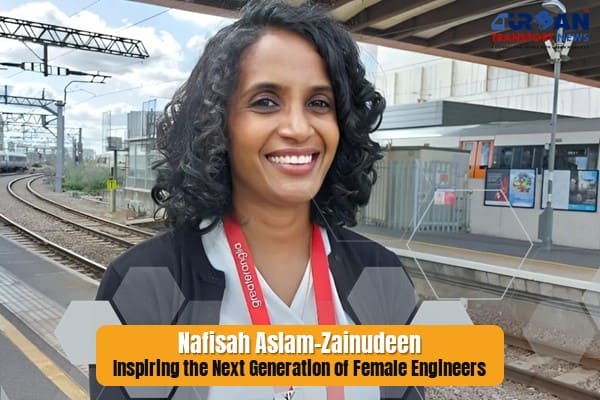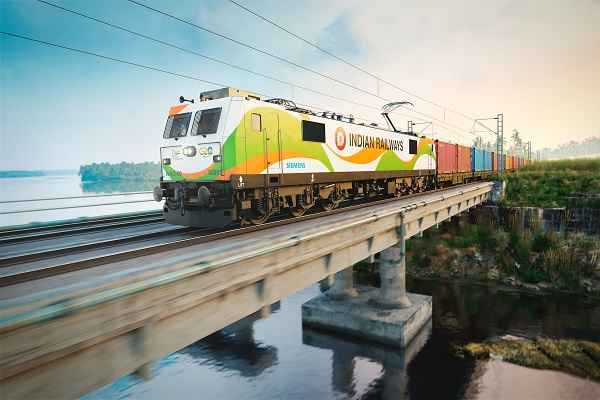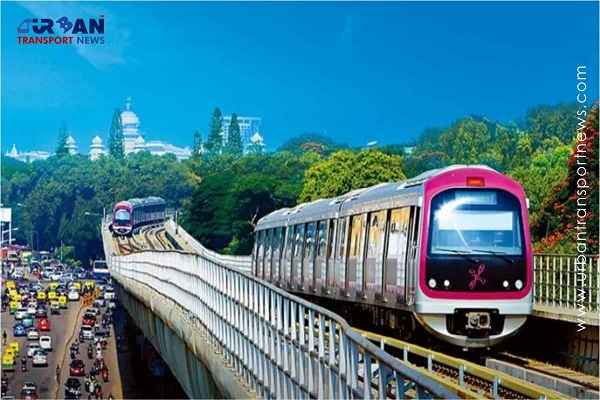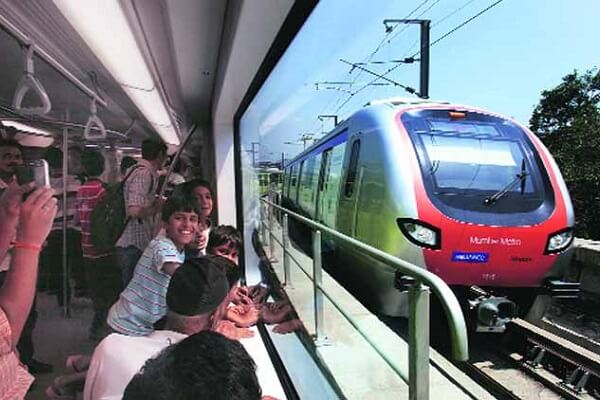 Nafisah Aslam-Zainudeen: Inspiring the Next Generation of Female Engineers
Nafisah Aslam-Zainudeen: Inspiring the Next Generation of Female Engineers DRA-DMRC JV awarded major contract for redevelopment of Ahmedabad Railway Station
DRA-DMRC JV awarded major contract for redevelopment of Ahmedabad Railway Station Revolutionizing Transportation: Hyperloop Technology in Saudi Arabia
Revolutionizing Transportation: Hyperloop Technology in Saudi Arabia India is not just a market, it is becoming a beacon of hope for the future: Siemens AG
India is not just a market, it is becoming a beacon of hope for the future: Siemens AGSATEBA acquires Rail Business of De Bonte Group in Belgium
 Regent to launch High-Speed Seagliders to transform coastal transportation in UAE
Regent to launch High-Speed Seagliders to transform coastal transportation in UAE California commences construction on $12bn Los Angeles - Vegas High Speed Rail Project
California commences construction on $12bn Los Angeles - Vegas High Speed Rail Project Kochi Water Metro floats tender to procure 15 more electric-hybrid ferries
Kochi Water Metro floats tender to procure 15 more electric-hybrid ferries Siemens Mobility-Hassan Allam Construction JV Sign Contract for UAE – Oman Railway Link
Siemens Mobility-Hassan Allam Construction JV Sign Contract for UAE – Oman Railway Link What is better public transport option for Bengaluru - RRTS or Metro Expansion?
What is better public transport option for Bengaluru - RRTS or Metro Expansion?
Breaking Barriers: Empowering Education with Free Transport for School Children

In the pursuit of equitable and inclusive education, innovative strategies have emerged to dismantle hindrances that obstruct the path to learning. Among these, the provision of free transport for school children stands as a transformative endeavour that transcends mere convenience, opening doors to education for all. Providing Free Transport to the school children encapsulates the essence of this initiative that not only removes transportation obstacles but also empowers young minds, fosters societal progress, and champions the values of accessibility and inclusivity. In an era where education is revered as a cornerstone of societal development, ensuring that every child, regardless of their socio-economic background or geographical location, can access quality learning opportunities is paramount. This title encapsulates the ethos of breaking down the physical, financial, and geographical barriers that often limit educational attainment. By embracing this initiative, governments and communities are not only enhancing the access to education but also creating a ripple effect of positive outcomes that extend well beyond the classroom, resonating throughout society.
Key Components of School Children Transport
It delves into the essential elements that constitute a successful and safe transportation system for students. This analysis explores factors such as reliable vehicles, well-trained drivers, and adherence to safety regulations, efficient route planning, and effective communication. By highlighting the significance of these components, the study underscores how they collectively contribute to creating a transportation environment that prioritizes student safety, accessibility, and convenience. Ultimately, it emphasizes that a holistic approach to school children transport is crucial for fostering an optimal learning experience and supporting students' well-being during their daily journeys to and from school.
Impacts of providing free Transport to School Children by the Government
Providing free transport to school children yields a range of impactful outcomes facilitated by government initiatives. This initiative not only enhances educational access but also addresses broader societal concerns. By ensuring equal access to education, it promotes inclusivity and bridges disparities among students from diverse backgrounds. Moreover, it contributes to reduced traffic congestion and pollution, aligning with environmental sustainability goals. Financial relief for families is a significant impact, allowing resources to be directed towards other essential needs. Additionally, the sense of safety and security that free transport offers enhances parental confidence and trust in the education system. By facilitating students' daily journeys and fostering a supportive environment, the government's provision of free school transport has far-reaching positive effects that extend beyond the immediate scope of transportation.
Ensuring Safe Journeys: Ways to Protect Children Traveling To and From School
The ways to Protect Children Traveling To and From School explores a comprehensive range of strategies to enhance the safety of students during their daily commutes. This analysis delves into aspects such as implementing proper pedestrian crossings, ensuring road infrastructure enhancements, encouraging walking and cycling, establishing secure waiting areas, and promoting community awareness. By highlighting these measures, the study underscores the multifaceted approach required to safeguard students, not only through physical safety measures but also through promoting awareness and fostering collaboration among stakeholders. Ultimately, it emphasizes that a combination of proactive measures contributes to a transportation environment that guarantees the well-being of children traveling to and from school
Safeguarding Students: Adhering to Regulatory Demands in the Provision of Free School Transport
Adhering to Regulatory Demands in the Provision of Free School Transport delves into the critical aspect of regulatory compliance when offering complimentary transportation to students. This examination underscores the significance of aligning transport initiatives with stringent safety and operational regulations. By investigating how adherence to rules ensures student well-being, this study emphasizes the implementation of measures such as driver qualifications, vehicle safety standards, and emergency protocols. It elucidates how a meticulous approach to regulation not only fosters secure transportation but also builds trust among parents and the broader community. This analysis ultimately emphasizes that, in the pursuit of enhancing accessibility and safety, strict regulatory conformity remains pivotal to the success of free school transport initiatives.
Federal Mandates: Ensuring Child Safety through School Bus Operator Safety Precautions:
It explores the pivotal role of federal institutions in establishing comprehensive safety guidelines for school bus operators. This analysis delves into how stringent driver qualifications, vehicle safety standards, child safety measures, and training protocols contribute to the secure transportation of students. By emphasizing the importance of these precautions, the study highlights the assurance they provide to parents regarding their children's safety. Ultimately, it underscores that a collaborative effort between federal institutions and school bus operators, rooted in rigorous safety measures, is instrumental in creating a transportation environment that prioritizes student security and parental confidence.
Quantifying Savings and Societal Gains: Assessing the Financial Benefits of Government-Provided Free School Transport
Assessing the Financial Benefits of the above said scheme delves into the multifaceted advantages brought about by offering complimentary transportation to school children. This comprehensive assessment explores not only the direct financial savings for families but also the broader societal gains. By analysing reduced traffic congestion, enhanced environmental sustainability, improved parental work productivity, and potential long-term economic benefits, this study sheds light on the holistic impact of government initiatives. Ultimately, it underscores how free school transport not only eases financial burdens but also contributes to a more efficient, sustainable, and prosperous society.
Empowering Sustainable Futures: The Necessity of Providing Free Transport to School Children in the Context of Sustainable Development Goals
Sustainable development is a global aspiration that envisions a balanced coexistence of economic progress, social equity, and environmental stewardship. Within this framework, providing free transport to school children emerges as a pivotal initiative that aligns with several Sustainable Development Goals (SDGs).The free transport to school children not only addresses immediate educational needs but also contributes to broader SDG objectives are given below:
|
S# |
SDG No |
SDG Objectives |
|
1 |
SDG 4 : Access to Quality Education |
By removing transportation barriers, this initiative promotes equal educational opportunities, particularly for children living in remote or economically disadvantaged areas. Students who can access schools without financial constraints are more likely to complete their education, enhancing their skills and contributing to future economic growth. |
|
2 |
SDG 10 : Reducing Inequalities |
It aims to bridge socio-economic gaps. Providing free transport to school children plays a critical role in achieving this goal by levelling the playing field. Children from marginalized backgrounds can access education without the financial burden of transportation costs, thus breaking the cycle of poverty and fostering social inclusion. |
|
3 |
SDG 5:Gender Equality&SDG1: Empowerment |
Equal access to education empowers girls and boys equally. By offering free transport, girls are more likely to attend school regularly, diminishing gender disparities in education. Educated girls become empowered women who can contribute effectively to their families, communities, and society at large. |
|
4 |
SDG 11: Sustainable Cities and Communities |
By reducing individual commuting in private vehicles, this initiative mitigates traffic congestion, air pollution, and carbon emissions. It contributes to the creation of sustainable urban environments that prioritize efficient transportation systems and improved air quality. |
|
5 |
SDG 13 : Climate Action |
Free school transport supports this goal by encouraging fewer private vehicles on the road, reducing the carbon footprint associated with daily commutes. It promotes environmentally friendly travel practices and encourages a culture of sustainability from an early age. |
|
6 |
SDG 17 : Partnerships for the Goals |
Achieving sustainable development requires collaborative efforts among governments, communities, and stakeholders. It involves coordination between educational institutions, transportation authorities, parents, and local communities. Such partnerships foster a shared commitment to educational equity and sustainable progress. |
Note:**- SDG : Sustainable Development Goals
Unlocking Educational Equality: Government's Contribution to Student Well-being through Free Bus Transport
It delves into the multifaceted advantages stemming from the provision of complimentary transportation services. It explores how free bus transport eliminates financial barriers, ensuring equal access to education for all students, highlights the reduction in traffic congestion and environmental impact through fewer individual vehicles on the road and also emphasizes the convenience for parents, enabling them to entrust their children's safety to reliable transport. Additionally, the initiative promotes a sense of community and fosters healthier lifestyles through walking or cycling options. Overall, the analysis underscores that government-provided free bus transport enhances education accessibility, student safety, environmental sustainability, and parental satisfaction, ultimately contributing to a holistic and enriching educational experience.
Fueling Economic Growth: The Contribution of Free School Transport to Regional GDP Enhancement
It examines the intricate link between education accessibility, transportation, and economic prosperity and highlights how government-provided free school transport goes beyond its immediate benefits by bolstering regional GDP. By enabling students to access education without transportation barriers, this initiative cultivates a skilled and educated future workforce. The resulting rise in educational attainment translates into enhanced employability, innovation, and productivity. Consequently, as these educated individuals contribute to the workforce and economy, the regional GDP experiences an upward trajectory. This study underscores the pivotal role that free school transport plays in not only ensuring equitable education but also catalysing sustained economic growth.
Navigating Budgetary Challenges: Overcoming Financial Hurdles in Implementing Free Transport for School Children
Overcoming Financial Hurdles in Implementing Free Transport for School Children delves into the strategic approach of tackling financial constraints when implementing free school transport. This exploration navigates the intricate landscape of budget allocation and identifies innovative avenues for resource optimization. By examining potential cost-sharing mechanisms, public-private partnerships, and targeted funding allocation, this study sheds light on practical solutions that can ease the financial burden on governmental budgets. It underscores the importance of collaboration, creative funding strategies, and prioritizing long-term benefits when striving to provide equitable transportation solutions to school children. Ultimately, this analysis underscores that, with a proactive and adaptive approach, budgetary challenges can be surmounted, ensuring the realization of accessible and affordable education transportation.
Funding Perspectives: International Institutions' Support for Free School Transport Initiatives
The funding international institutions such as the World Bank, Asian Development Bank (ADB), and European Bank have recognized the significance of free school transport in the context of funding educational initiatives. These institutions emphasize the importance of accessible education and sustainable development. They view free school transport as a means to ensure equitable access to education, especially for marginalized communities. These organizations often advocate for investments in transportation infrastructure as part of their educational support programs, recognizing that eliminating transportation barriers can lead to increased school attendance and improved learning outcomes. Additionally, they highlight the potential social and economic benefits of free school transport, including reduced traffic congestion, enhanced gender equality in education, and improved overall well-being of students and communities. In funding discussions, these institutions prioritize projects that align with their goals of promoting education, equality, and sustainable development through initiatives like free school transport.
Elevating Student Safety Solutions: Innovations Shaping the Future of School Bus Security
Unveiling Forward-Thinking Safety Measures for Students on School Bus Journeys, this analysis explores inventive strategies dedicated to bolstering student security during transit. It delves into the realm of advanced technological interventions, including AI-powered surveillance systems, enhanced seat belts, specialized cameras, vivid lights, and clear signs, as well as affable bus monitors, GPS advancements, comprehensive emergency plans, intelligently designed stops, supportive traffic guides, innovative bus designs, and even interactive talking buses. Furthermore, it probes the potential of autonomous vehicles and driver-assist technologies as a means to diminish human error, thus redefining safety protocols in the realm of school transportation. By highlighting these futuristic solutions, the analysis underscores the commitment to evolving safety standards, providing parents and communities with greater peace of mind while ensuring students' safe transportation to and from school.
Key Takeaways
- Inclusive Education: Free school bus transport ensures equitable access to education, breaking down barriers for students from all backgrounds.(Improved Attendance, Reduced Dropout Rates etc..)
- Student Safety: Modernizing school buses with essential safety components like seat belts, emergency exits, and surveillance systems, coupled with rigorous traffic rule compliance and routine vehicle upkeep, substantially mitigates the potential for accidents.
- Financial Relief: Families benefit from reduced financial burden, redirecting resources to other essential needs.
- Environmental Impact: Centralized transportation contributes to reduced traffic congestion and a greener environment.
- Parental Convenience: Providing reliable transport simplifies parents' daily routines and enhances overall satisfaction.
- Community Bonding: Shared transport experiences foster a sense of unity and belonging among students and families.
- Academic Focus: Reliable transportation enables students to focus on learning, participation, and personal growth.
- Equity Promotion: The initiative promotes educational equity by ensuring every student can access quality education.
- Positive Societal Change: Well-executed free transport solutions contribute to a more connected, sustainable, and educated society.
- Holistic Development: The comprehensive benefits of free transport extend beyond logistics, enhancing students' overall well-being and future prospects.
- Alternate Transportation Modes: To alleviate traffic and promote health, schools should urge students residing within a one-Km radius to walk or cycle, facilitated by secure pathways and dedicated bike lanes. This dual approach enhances fitness and minimizes congestion.
- Public-Private Partnerships: It involves schools, transport firms, and local enterprises for inventive approaches. Through sponsorships, subsidies, or shuttle services, equal student transportation access becomes attainable.
- Technology Integration: By integrating GPS tracking, real-time bus monitoring enhances security, updates parents about their children's locations, and improves safety measures and communication.
- Investment in Infrastructure: Government and local authorities must prioritize enhancing road infrastructure around schools, encompassing pedestrian crossings, traffic signals, and secure waiting zones for students, ensuring their safety and efficient mobility.
Conclusion
In striving for better solutions in providing free transport to school children, it is evident that a multi-faceted approach combining convenience, safety, equity, and sustainability is essential. By meticulously addressing logistical challenges, embracing technological innovations, adhering to stringent safety standards, and fostering community engagement, we can create a transportation system that not only ensures the timely and secure transit of students but also cultivates a positive educational environment. Such solutions not only enhance access to education but also alleviate financial burdens, promote parental satisfaction, and contribute to a more cohesive and environmentally conscious society. Ultimately, by embracing these comprehensive solutions, we pave the way for a brighter future where every child can seamlessly journey towards knowledge and growth.







